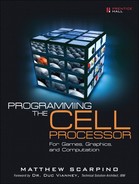The Cell Broadband Engine Architecture® (Cell/B.E.) defines a new processor structure that extends the 64-bit Power Architecture® technology and incorporates unique features that support critical real-time response of highly parallel, computationally intensive code. The first implementation of the architecture has resulted in a single device of heterogeneous processors mixed with simultaneous multithreading and special computational “accelerator” cores for more performance and efficiency gains. The processor comprises a vector Power Processor Element (PPE) with two levels of cache and eight independent Synergistic Processor Elements (SPEs), each with its own multilevel storage organization. In addition to processor-level parallelism, each processing element has Single Instruction Multiple Data (SIMD) units that can process from 4 words up to 16 characters per processing cycle, and globally consistent Direct Memory Access (DMA) engines that provide a rich set of DMA commands for seamless communication between all Cell/B.E. processing elements. The dual thread, 64-bit PPE controls and runs the operating system, manages system resources, and coordinates work sent to the SPEs, while the SPEs are dedicated only to the compute thread and its data.
Although the Cell/B.E. processor was initially intended for application in game consoles and media-rich consumer-electronics devices, a much broader use of the architecture is starting to emerge to handle streaming workloads found in today’s applications across such industry segments as health care, life sciences, petroleum exploration, financial services, digital media, electronics, government, and education. To fully harness the power of Cell/B.E., developers need to use different programming models and to write multithreaded code that ensures the SPEs are well utilized and work is equally off-loaded across the SPEs.
This book is the first commercially published book written for those who want to program the Cell/B.E. It provides comprehensive learning material for developing multithreaded code that allows an application structured for parallelism to execute much more efficiently on those SPE accelerators. It starts with the IBM Software Development Kit (SDK) for Multicore Acceleration Version 3.0, which consists of run-time tools (such as the Linux kernel), development tools, GNU toolchain, software libraries and frameworks, performance tools, a system simulator, sample source codes and benchmarks—all of which fully support the capabilities of the Cell/B.E. The book discusses the device’s architecture, including the PPE vector processing unit, SPE SIMD capabilities, and DMA communication mechanisms. The book also details SPU programming and exploitation of SPU storage by software module overlay and software managed cache. It includes an in-depth section on libraries, ranging from the basic vector and matrix libraries to BLAS, MASS, FFT, and Monte Carlo libraries.
Multicore processing is the future trend of the computing industry. Cell/B.E. offers a general-purpose, programmable multicore processor available to developers through high level programming languages such C/C++ and Fortran. However, in order to fully leverage the processor parallel capabilities, the application needs to be properly designed in both code and data. This book describes the processor in enough details and contains many practical code examples to get you off the ground to write your first Cell/B.E. application. Such experience should give you a competitive edge when working with other multicore systems, or as a foundation to work on Cell/B.E. homogeneous and/or hybrid clusters that are being deployed to support a wide range of high performance computing workloads.
Duc J.Vianney, Ph. D.
Technical Solution Architect[1]
Education Lead—Cell/QUASAR Ecosystem & Solutions Enablement
IBM Systems & Technology Group, Industry Systems Division
[1] What is the IBM definition of “Technical Solution Architect”?
“This role assumes overall technical responsibility for the success of solution construction, implementation, and system integration in a technology, industry, or business specialty. They deliver new and complex high quality solutions to clients in response to varying business requirements. They utilize in-depth knowledge of leading-edge products and technology in conjunction with industry and business skills to influence clients.”
